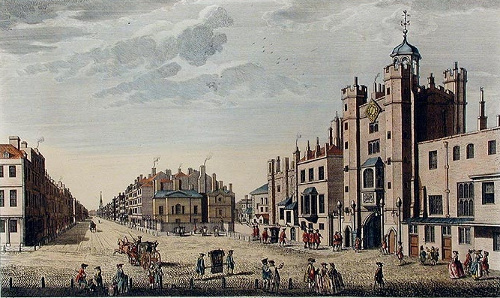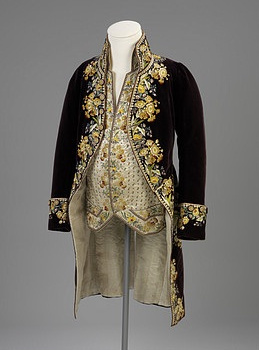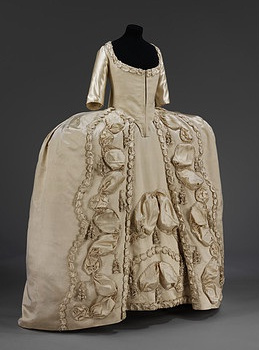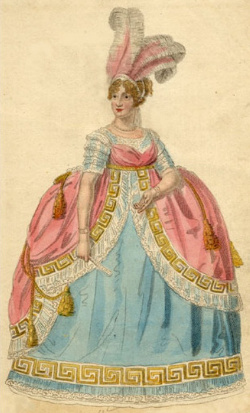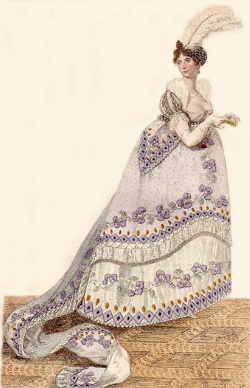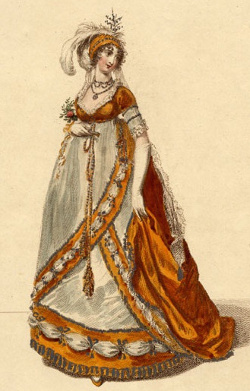|
in Chapter Six of Pride and Prejudice, Sir William Lucas, observing the dancing in his home, attempts both to interest Darcy in the pastime and to display his own familiarity with the highest in the land.
“I doubt not that you are an adept in the science yourself, Mr. Darcy.” “You saw me dance at Meryton, I believe, Sir.” “Yes, indeed, and received no inconsiderable pleasure from the sight. Do you often dance at St. James’s?” “Never, sir.” “Do you not think it would be a proper compliment to the place?” “It is a compliment which I never pay to any place if I can avoid it.” (25-26)
As is so often the case, Jane Austen has packed a world of meaning into this brief exchange. Contemporary readers would have known exactly what was involved in “dancing at St. James’s” and would thus have gleaned nuances of character and perhaps even a hint of Austen’s own political preference from this conversation. Modern readers, however, may need to have some of these subtleties revealed. This essay discusses the etiquette and details of dancing at the court housed in the Palace of St. James, the special attire required to dance at court, and the dances performed, both by type and, on occasion, by specific name.
With his comment that he never dances at St. James’s, Mr. Darcy reveals that he is neither an aspirant to fashion nor (like Sir William) a sycophant at the Hanoverian Court: St. James was the official palace of the King, and it was there that the elaborate balls were held to celebrate the annual official nativities of the King and Queen (in June and January, respectively), the periodic recoveries of the King from illnesses, receptions of foreign nobility, and other important occasions. Balls at St. James’s were not assemblies formed purely for pleasure and entertainment—they were among the most formal events that took place at court.
A descendant of a family loyal to the Stuart cause, Jane Austen was not fond of the Hanovers (LeFaye 58-59), and her early general dislike was fueled by the shocking behavior of the Prince of Wales from the age of his majority on, especially towards his wife. So when Mr. Darcy scorns to dance at the Court of St. James’s, it may be in part because, like his creator, his sympathies lie with the Stuarts. It may also be because the event was apparently extraordinarily dull.
Socially and politically conservative in nature, King George III (1738-1820) was the third Hanover to rule, the first to be born in England, and the first whose native tongue was English rather than German. He ascended the throne in 1760 and married Sophia Charlotte, Princess of Mecklenburg Strelitz in 1761, meeting her for the first time on their wedding day. They subsequently had fifteen children. Their eldest son, the future George IV, was born in 1762, making him thirteen years older than Jane Austen. George III suffered from porphyria and had an episode of madness in the summer of 1788; the Prince of Wales was almost named Regent then, but the King recovered in February of 1789. In 1804 and 1810 he suffered further episodes, finally sinking into permanent madness in 1811, whereupon his eldest son (later George IV) was named Prince Regent.
The King, sometimes known as “Farmer George,” was in many ways a conservative and family-oriented man. Fond of his children when they were young, he was often at odds with the behavior of his sons, and kept his daughters close at court. Balls at St. James’s were, then, largely a family affair, with the young princes and princesses dancing with each other or with a carefully selected handful of the nobility.
What was the Court like? In 1761-62, when Count Carl von Kielmansegge visited London for the coronation of George III and Queen Sophia Charlotte, he naturally visited the Court at St. James’s and was rather disappointed: the building was old, the rooms small and “spoilt by the bad and old furniture” and altogether insufficient to house the “several thousand people, amongst whom are hundreds of ladies in large hoops,” who attended the State events at Court (198-99). The Count, a careful observer, described the ballroom:
The place for dancing is divided from the rest of the room by a railing; inside this space nobody is admitted except the royal family and suite and those who dance minuets. All the rest of the room is occupied by benches, and a gallery runs all round for lookers-on and the band. Only one couple dances the minuet at a time, and as there are usually more ladies than gentlemen, each lady dances only one minuet, and every man two. (199)
Graf von Kielmansegge noted that if one wished to dance a minuet, one had to send one’s name the previous day to the Duke of Devonshire, the King’s Chamberlain, who called up participants in strict order. “Rank in England is decided exclusively according to class, and not according to service,” wrote the Count; “consequently, the duchesses dance first, then marchionesses, then dukes’ daughters, then countesses. Foreigners have no rank at all in England, so they may not dance before the lords and barons; after them, all the rest who have no rank and happen to be near, are called up by the Chamberlain” (200). He added that towards midnight, “as soon as the second English dance [i.e., a country dance] has taken place, the King and Queen retire, as English etiquette does not allow them to dance at public parties” (200-201).
Writing in 1829, Mr. G. Yates provided more detail about the formality of a ball at court in the days of George III. Yates was in his youth an aide-de-campe to court dancing master Monsieur Charles Le Picq (1744-1806), who worked in London from 1782 to 1787. Here Yates describes the balls of the mid-1780s:
On the evening of the ball, the Lord Chamberlain, with his wand of office, stood within the railing that encompassed the space for dancing, with the list of dancers in his hand. When the ball-room was as full as was thought convenient, the door of entrance for the company was closed till the ball was over; . . . On their Majesties’ entrance the court band, stationed in the music gallery at the opposite end of the room, commenced playing the march in Judas Maccabeus,1 which by the king’s command was always performed on this occasion. After their Majesties had walked round the inside of the [dancing] space . . . and had [greeted a few nobles], they retired to their chairs, (for there was no throne) and this was the signal for the band to cease. Then the Lord Chamberlain advanced to the Prince of Wales and his royal sister, making his obeisance before them, on which they arose and performed the same ceremony before their Majesties, retiring backwards until they arrived at the opposite end of the open space, when the band immediately commenced playing a minuet. The court dancing-master (Monsieur [Philip] Desnoyer [1700-88]) spread the lady’s train, which was exceedingly long and heavy with gold or silver, and which, during the respectful preliminary, had been supported on the hoop. Having concluded a minuet, the obeisance was repeated to their Majesties; and in the same manner proceeded the other members of the royal family and nobility according to precedence, going through the same ceremonies. The gentleman did not go up a second time to make obeisance if he was again required to dance another minuet (as was generally the case); but waited for another lady, who was under the necessity of going through the awful ceremony alone. A country dance or two followed when the minuets were over; for cotillons or quadrilles were not then in fashion at court. (Yates 15-17).
Popular journals reported on all these important occasions, noting especially the attire of the royal guests but occasionally mentioning the country dances performed. For example, in 1787, the year that Jane Austen turned twelve, The European Magazine and London Review printed a bulletin on the celebration of the Queen’s birthday, celebrated on Thursday, January 18. After listing the names of the guests in order of rank—the royal princesses, the Duke of Cumberland, the Archbishop of Canterbury, twelve non-royal dukes, three marquises, twenty-seven lords, five duchesses, two marchionesses, and nine titled ladies plus the Lady Mayoress of London—the anonymous reporter then observed that the ballroom was “not so much crowded as on similar occasions.” He then listed the dancers who performed the minuets: first the elderly Duke of Cumberland with his nieces Princess Augusta and Princess Elizabeth, then Earl Delawar with the Countess of Salisbury and Lady Malden, etc. After the minuets were danced, eight couples, headed by the Duke of Cumberland dancing with Princess Augusta and Earl Delawar dancing with Princess Elizabeth, danced three country dances: Good Morrow to Your Night-cap, La Belle Catherine, and The German Spa. The ball, which had begun at nine, ended at half-past eleven (“Queen’s Birth-Day”). Later that year, the court reporter noted that the celebration of the King’s birthday “exhibited but little either of splendour or novelty,” perhaps because of the absence of the Prince of Wales, who was recovering from an illness. Only two country dances were performed: La Belle Chasseuse and La Nymphe (“King’s Birth-Day” 448). Modern dancers would be disappointed at this glacial pace and limited offering!
Dances performed at court
For most of Austen’s life, the dances performed at court were the minuet and the country dance. From Mr. Yates’s comment, above, it would appear that towards the end of the eighteenth century, cotillons were also performed. A French dance popular in England after the Treaty of Paris that concluded the Seven Years War (1763), the cotillon was a dance for two or four couples in a square, featuring complex footwork and opportunities for individuals to display their dancing skills.
In the 1790s English country dance figures set to Scottish tunes became all the rage, even at the change-resistant court: on 10 January 1793, for example, Queen Charlotte gave a “superb and magnificent” ball and supper at Windsor. “The country-dances were all to Highland tunes,” wrote the Queen’s contemporary biographer, “and their Majesties were gratified with a set of Scotch reels, which entirely dissipated that heavy dulness [sic] to which the stately ball-room had hitherto been subject” (Oulton 323).
The quadrille did not become popular in England until after the Peace celebrations of 1814; likewise the waltz was not danced at court until 12 July 1816, when it was included on the program of the Prince Regent’s Fête at Carlton House. While no royalty danced, the London Times wrote,
We remarked with pain that the indecent foreign dance called the “Waltz” was introduced (we believe for the first time) at the English court on Friday last. This is a circumstance which ought not to be passed over in silence. National morals depend on national habits; and it is quite sufficient to cast one’s eyes on the voluptuous intertwining of the limbs, and close compressure on the bodies, in their dance, to see that it is indeed far removed from the modest reserve which has hitherto been considered distinctive of English females. So long as this obscene display was confined to prostitutes and adulteresses we did not think it deserving of notice; but now that it is attempted to be forced upon the respectable classes of society by the evil example of their superiors, we feel it a duty to warn every parent to avoid exposing his daughter to so fatal a contagion. (qtd in Rust 69)
The Times was doomed to fail in its crusade against the waltz, but it was also out of date, as the court was, generally speaking, behind the times in all trends in dance. The cotillon, Scottish reel, quadrille, and waltz all enjoyed popularity in fashionable society well before they were recognized at court. The reverse was true as well: while the minuet was still danced at court until the Regency, it had died out in the provinces by as early as 1793, when Jane was seventeen. We know this because when Eliza Smith married the Austens’ wealthy neighbor William John Chute in late 1793, the young woman was apparently so nervous about dancing at public balls that her mother wrote to her, “I am glad for your Sake there are no Minuets at Basingstoke [the public Assembly closest to Steventon parsonage], I know the terror you have in dancing not that you have any occasion for such fears” (qtd in Tomalin 93)
Court dress
It is said that Ginger Rogers danced everything that Fred Astaire did but backwards and in high heels, but even Miss Rogers’s skill might have been taxed by the formal court hoop. Very wide skirts of a rectangular shape—so wide that ladies had to turn sideways to pass through doorways—had been the kick of fashion in the 1740s, but hoops were retained for court wear until Queen Charlotte’s death in 1818. Indeed, ladies who wished to dance minuets at Bath or other public assemblies were also required to wear court hoops and lappets (streamers of lace depending from the backs of their head-dresses). The hoops changed shape slightly over the years, until by 1806, in a nod to the high-waisted fashion popular then, they projected out directly from under the breasts.
The hoop and its train were a formidable obstacle to graceful movement: not even dexterity, wrote Mr. Yates, could make it appear anything but grotesque and disfiguring or at least risible.
It is difficult to describe the whimsical appearance of the large court hoop during this dance. . . . Not even the familiar acquaintance with its appearance which length of years, from one reign to another, had established, could divest it of a large share of ludicrous excitement when put in motion by the lively dance; and though on these occasions every thing was conducted with an air of reserve and etiquettish seriousness, the spectacle that these light dances afforded, nothwithstanding the softening down that the utmost dexterity could effect, completely set gravity at defiance. (Yates 18-19)
Mr. Yates further noted that ladies were accustomed to practice their curtsies and their dancing at home in the under-hoop of bent cane and glazed calico, with a long sheet or tablecloth to represent the train (Yates 22-30).
The massive hoops presented another challenge: getting in and out of the carriage. In her memoirs of the years 1783 to 1812, Susan Sibbald recalled that as a girl she stood outside St. James’s frequently when Queen Charlotte held a drawing-room, in order to see the ladies in their hoops:
It was very awkward for [the ladies] when either getting in or out of a carriage as the hoops being too large in circumference, to allow them to pass through the carriage door, without holding the hoop up on one side or down on the other so that the side they held up showed their little legs and feet which appeared small from the immense rotundity of their dresses, and when they sat in a carriage the hoop came up nearly to their shoulders so that their hands with the fan, could only be seen. . . . (Sibbald 100)
The anonymous reporters of court events in monthly magazines like The European Magazine and London Review provided exhaustive detail on the gowns that individual noble ladies and gentlemen wore. For example, at the celebration of the Queen’s birthday in 1787 noted above, the reporter wrote that the King wore purple velvet, embroidered with gold, with diamond buttons and a brilliant diamond star; the body of the Queen’s dress was lemon satin, with a coat of white crepe gauze adorned with rows of black lace and blue ribbons; and the two princesses were dressed alike in gold tissue (50-51). Fashion magazines like La Belle Assemblée provided even more detail, as when describing the court dress of the Princess of Wales worn for the celebration of the King’s birthday on 4 June 1807. After the standard panegyric on how the princess’s dress was “superior for taste and magnificence to all others,” the reporter noted,
The body and ground of the drapery was formed of a rich silver and lilac tissue; with a most superb border, composed of emeralds, topazes, and amethysts, to represent the vine-leaf and grapes. The train and petticoat of silver tissue; bordered all round like the drapery; and each terminated with a most brilliant silver fringe of a strikingly novel formation. Rich silver laurel and arrow on the left side, to loop up the train. Head-dress of diamonds and amethysts, tastefully disposed; with high plume of ostrich feathers. Neck-dress, the winged ruff, a la Mary Queen of Scots; sleeve ornaments to correspond. Amethyst necklace and earrings, with Maltese cross; diamond armlets and bracelets. White satin shoes, with rich silver rosettes. French kid gloves, above the elbow. Fan of imperial crape, studded with amethysts and topazes.
While most of La Belle Assemblée’s “fair correspondents” could not dream of owning this gown or jewels, they would be able to take fashion plates like this and the written details of sleeves, necklines or trimmings to their modistes in order to create a less sumptuous approximation of such a gown for their private use.
The splendors of court balls
Some of the balls at court were, in the words of both Miss Bates and Austen’s cousin Eliza de Feullide (who attended St. James’s and also the Court of Marie Antoinette)—“like those of Aladdin.” Several grand balls, for example, were given in 1789 to celebrate the King’s return to health, and one of the most splendid was that given by the Marquis del Campo, the Spanish ambassador, at Ranelagh. A contemporary observer noted that the front of the house was illuminated “in a novel manner,” and the portico immediately leading to the rotunda “was filled on each side with rows of myrtle, aromatic shrubs, and rose trees, intermixed with carnations and pinks” (Watkins 365). The lower boxes, from which the lesser nobility viewed the entertainments, were in the appearance of a Spanish camp tent, striped blue and red and each tent guarded by a boy dressed in the Spanish uniform. The gallery formed a temple of Flora, “lighted by a number of gold baskets, containing wax tapers, ornamented with roses and other flowers” (365). The Queen’s box was hung with crimson satin lined with white, with festoons of gold and a crown on top (365-66). The entertainment was no less splendid than the surroundings:
Opposite to Her Majesty’s box was a light temple or stage, on which a Spanish dance was performed by children: at another part were beautiful moving transparencies; and in a third was a lottery of valuable trinkets, consisting of six hundred prizes, according to the number of ladies invited. The greatest prize was an elegant gold watch, richly ornamented with diamonds, which fell to the lot of Miss Sturt. The other prizes consisted of rings, bracelets, fans, necklaces, &c. Her Majesty drew an etwee4 case with a beautiful medallion of the King. Women, ornamented with wreaths of flowers, made tea; and one hundred valets in scarlet and gold, and as many footmen in sky blue and silver, waited on the company. The fire-works in the garden were uncommonly beautiful; and to give additional splendour to the scene, the ambassador caused twenty pleasure-boats, illuminated with lamps, to sail up and down the river, letting off rockets as they passed. (366)
While the surroundings might be beautiful, being presented to the King and Queen and dancing at St. James’s was not necessarily a pleasurable experience: Yates comments on the embarrassment of many, especially those girls making their first ballroom appearance. He claimed however, that everyone was pleasant and affable, including their Majesties, and that when the latter left the room, the refreshments—and, one senses, the party—began (Yates 20-21).
And even at court ugly facets of life entered. For example, at the ball given to celebrate the King’s official birthday in 1789, the King himself was absent—shaken by the recent, nearly fatal, duel between his second son, the Duke of York, and a Colonel Lenox, who was the son of one of the Queen’s ladies-in-waiting. Queen Charlotte carried on without his support but was made subject to an event that evening that her contemporary biographer called “equally unexpected, disagreeable, and unprecedented.”
Notwithstanding the furor created by the duel, and ignoring the established etiquette at Court that forbade standing up for a country dance if one had not danced a minuet first, Colonel Lenox appeared with Lady Catharine Barnard as his partner. The Prince of Wales, dancing with his sister the Princess Royal (Charlotte [1766-1828]), did not immediately perceive him, but when he did, “struck with the impropriety” of the action, he reacted strongly (Watkins 368). Just as the colonel was about to turn the Princess in the dance, the Prince took her hand and led her to the bottom of the dance. One of his brothers, however, was not so particular:
The Duke of York [Frederick (1763-1827)] and the Princess Augusta [1768-1840] came next, and they turned the colonel without the least particularity or exception. The Duke of Clarence5 with the Princess Elizabeth [1770-1840] came next, and his royal highness followed the example of the Prince of Wales. The dance proceeded, however, and Colonel Lenox and his partner danced down: but when they came to the Prince and Princess, his royal highness took his sister, and led her to her chair by the Queen. Her Majesty then addressing herself to the Prince, said, “You seem heated, Sir, and tired.” “I am heated and tired, Madam,” said the Prince, “not with the dance, but tired of dancing in such company.” “Then, Sir,” said the Queen, “it will be better for me to withdraw, and put an end to the ball.” “It certainly will be so,” said the Prince, “for I never will countenance insults given to my family, however they may be treated by others.” At the end of the dance, accordingly, Her Majesty and the princesses withdrew, and thus the ball concluded. The Prince, with his natural gallantry, afterwards explained to Lady Catharine Barnard the reason of his conduct, and assured her ladyship that it gave him much pain to be under the necessity of acting in a manner that might subject any lady to a moment’s embarrassment. (Watkins 368-369).
This account reinforces for modern readers the expected behavior of the period at formal balls, and the shocking nature of the breaches of that behavior. Colonel Lenox had broken the rules both of propriety (by showing up at all after nearly killing the Duke) and of order (daring to dance a country dance without having first acknowledged the rank of society by performing a minuet). The Prince of Wales’s response was to disturb the order of the set—itself a gross breach of conduct—not once but twice in order to protect his sister from having her hand sullied by taking the hand of the duelist.
Pomp and poverty
It is improbable that Jane Austen ever attended St. James’s—she did not move in those elevated circles nor could she have afforded the expensive court dress. Her lively cousin the Comtesse de Feuillide did attend, however, “wearing a dress so heavily hooped it was quite fatiguing to stand up in” (qtd in Tomalin 47). Eliza was part of the society that allowed her to call upon duchesses, obtain a voucher for Almack’s, and stay out until 5 a.m.—all activities cited by her in a letter of 9 April 1787 to her cousin Philadelphia Walter (Tomalin 47). Jane would have undoubtedly have heard Eliza’s tales of the brilliance of the court balls and drawing-rooms, but, following her own advice to her aspiring-writer niece Anna, she chose only to describe what she knew at first hand. Thus, neither she, nor Mr. Darcy, nor we the readers ever meet at the Court at St. James’s.
Notes
1. The march referred to is probably “See the Conquering Hero Comes,” written by George Friedric Handel (1685-1759) in 1747. He inserted this popular march into Judas Maccabeus, an oratorio written in 1746 about a hero from Jewish sacred history victorious in battle against pagan enemies. The opera was intended as an allegory for the victory against the Scots at Culloden by the forces of Handel’s patron, King George II.
2. “The Marchioness of Townsend in her full Court Dress as worn by her Ladyship on the Queen’s Birth Day 1806,” from La Belle Assemblée (Mar. 1806). This image is from the collection of Candice Hern (http://www.candicehern.com/) and used by permission.
3. “Her Royal Highness the Princess of Wales in her Court Dress on the 4. of June 1807, as authentically taken from the real dress made by Mrs. Webb of Pall Mall,” from La Belle Assemblée (July 1807). This image is from the collection of Candice Hern (http://www.candicehern.com/) and used by permission.
4. Original spelling. The word is “etui,” and the object is a case for small articles such as scissors, tweezers, etc.; perhaps the lottery was rigged to award the Queen this prize with the image of her husband.
5. The future William IV (1765-1837). A sailor, he had sought to be made a royal Duke like his brothers and, when George III proved reluctant, put pressure on him by stating that he would then run for a seat in the House of Commons. George III created him Duke of Clarence and St Andrews and Earl of Munster on 16 May 1789. Perhaps his recent ascendancy to the title made him inclined to follow his elder brother’s example.
6. This image is from the collection of Candice Hern (http://www.candicehern.com/) and used by permission.
Works Cited
Austen, Jane. Pride and Prejudice. 3rd ed. Ed. R. W. Chapman. Oxford: Oxford UP, 1932. Kielmansegge, Friedrich. Diary of a Journey to England in the Years 1761-1762. London: Longmans, 1902. King’s Birth-Day.” The European Magazine, and London Review. 11 (Jun. 1787): 448-50. LeFaye, Deirdre. Jane Austen: A Family Record. Cambridge: Cambridge UP, 2004. Oulton, W. C. Authentic and Impartial Memoirs of Her Late Majesty Charlotte, Queen of Great Britain and Ireland. London: Robins, 1819. Queen’s Birth-Day.” The European Magazine, and London Review. 11 (Jan. 1787): 50-52. Rust, Francis. Dance in Society: An Analysis of the Relationship and Society in England from the Middle Ages to the Present Day. 1969. London: Routledge, 2003. Sibbald, Susan. Memoirs of Susan Sibbald, 1783-1812. Ed. Francis Paget Hett. London: Lane, 1926. Tomalin, Claire. Jane Austen: A Life. New York: Vintage, 1999. Watkins, John. Memoirs of Her Most Excellent Majesty Sophia-Charlotte, Queen of Great Britain. London: Colburn, 1819. Yates, G. The Ball; or, A Glance at Almack’s in 1829. London: Colburn, 1829.
|


